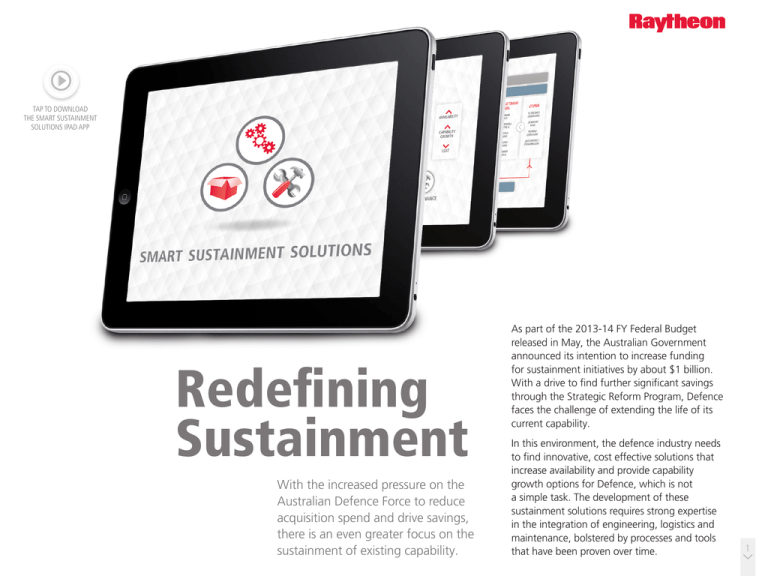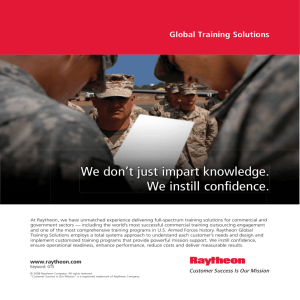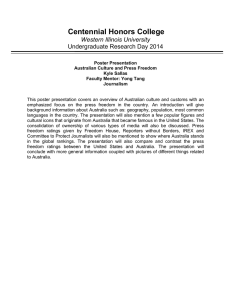With the increased pressure on the Australian Defence Force to
advertisement

TAP TO DOWNLOAD THE SMART SUSTAINMENT SOLUTIONS IPAD APP Redefining Sustainment With the increased pressure on the Australian Defence Force to reduce acquisition spend and drive savings, there is an even greater focus on the sustainment of existing capability. As part of the 2013-14 FY Federal Budget released in May, the Australian Government announced its intention to increase funding for sustainment initiatives by about $1 billion. With a drive to find further significant savings through the Strategic Reform Program, Defence faces the challenge of extending the life of its current capability. In this environment, the defence industry needs to find innovative, cost effective solutions that increase availability and provide capability growth options for Defence, which is not a simple task. The development of these sustainment solutions requires strong expertise in the integration of engineering, logistics and maintenance, bolstered by processes and tools that have been proven over time. 1 Equally important is the ability to share data through a common source database, allowing for timely and accurate information to support decision making and drive down costs. By taking a holistic capability view and developing an integrated, systems engineering approach to sustainment, Raytheon Australia has redefined how to deliver cost savings while increasing the availability of existing Defence capabilities. This unique model for delivering sustainment has enabled Raytheon Australia to significantly increase the availability of systems on multiple programs for Defence, most recently extending the life of type of the Australian Defence Air Traffic System by five years. On the Collins class submarine program, the company has increased the availability of the combat system by decreasing the turnaround time of critical assets to just four weeks. The availability of the APG-73 program was improved by transitioning the sustainment activities from the US-based original equipment manufacturer to Raytheon Australia, with the company now repairing 60 per cent of assets in-country. Guided Weapons Systems: How in-country sustainment solutions will improve availability With more than 24 different types of guided weapons in its portfolio, the Australian Defence Force (ADF) has a critical weapons inventory that represents billions of dollars in capital investment. In the late 1960s the Royal Australian Navy (RAN) first equipped its ships with guided weapon capabilities with the introduction of the Charles F. Adams class of destroyers. Over the decades that followed, the RAN steadily and significantly grew the level of capabilities on its surface combatants. Today, each ship has its own suite of guided weapon systems for air defence and surface warfare. This expansive suite of guided weapons plays a vital role in protecting Australia and its interests. Because these systems are such a critical capability for Australia, it is important that they remain available to the RAN to support operations. Managing the availability of such weapons relies upon its sustainment process. The sustainment of guided weapons is a complex task, due to the fact that there are multiple organisations and steps involved. For weapons of US origin, sustainment is performed under Foreign Military Sales arrangements with engagement from the original equipment manufacturer (OEM) and Australian Defence Force (ADF). But what if this comprehensive in-country testing and repair capability existed in Australia? This would mean that guided weapons capability could be tested and repaired in just four months rather than two years. And it is a possible scenario. This US testing equipment could be made available for the ADF to use in-country if both parties agreed to an appropriate licensing arrangement to allow greater testing of guided weapons parts in Australia. One approach to developing such a model would be to engage local defence industry to partner with their US parent companies and the ADF to deliver in-country smart sustainment solutions for these capabilities. For example, of the ADF’s suite of 24 guided weapons, Raytheon is the prime contractor for more than half of these systems. As an in-country provider of smart sustainment solutions, Raytheon Australia can work closely with its US parent company and the ADF to ensure compliance and deliver a more streamlined support model. Raytheon Australia’s proven smart sustainment solutions are based on a systems approach that draws upon the collection of timely and accurate data from engineering, maintenance and supply support. Ultimately, this model drives towards a “single source of the truth” to improve availability whilst reducing costs. Defence Calibrations: How big data improved availability and cut costs TAP TO DOWNLOAD THE SMART SUSTAINMENT SOLUTIONS IPAD APP TAP TO DOWNLOAD THE GUIDED WEAPONS CASE STUDY One specific opportunity as part of this model would be the in-country establishment and operational launch of an Augmented Intermediate As part of this process, the ADF is largely reliant Logistic Maintenance Facility (AILMF) forRaytheon the Australia also acknowledged an on overseas repair and has a limited in-country While large scale platform-based Evolved Sea Sparrow Missile (ESSM). This would be to improve the turnaround time from opportunity testing and maintenance capability. Many of the programs are often at defence a new test capability for Australia and would allow capability pick up to drop off. The team partnered capabilities that are in need of testing and repair the in-country testing for and repair of guided the centre offorpublic attention with Star Track, an industry-leading express freight require sea transport back to the US, resulting in sections, further reducing turnaround times. and logistics company that could more efficiently better or worse, most of these an average turnaround time of two years. move serviced capability from one location to This capability wouldwithout also allow the ADF to replace programs would not exist This means that guided weapon parts can be out the next. approved components that will significantly the calibration and testing services of the country for years at a time, undergoing improve the reliability and, in some cases the these two improvements were in place, Once testing and repair in the US, where therethat is an are critical to keeping them capability, of the ESSM inventory. By implementing the team took it one step further by linking Star extensive and comprehensive inventory of testing operational. the AILMF, the ADF will be able to complete Trackthis to the centralised database. In doing so, equipment. the team was able to book new jobs whilst Star Track was delivering on other jobs – a benchmark The calibration and testing capability for the new efficiency, which saved one full day of turn Australian Defence Force (ADF) was a service that around time. the ADF managed in-house until 2010, when Raytheon Australia was awarded a contract to provide this service. Drawing upon the lessons learned from the F-111 sustainment approach, Raytheon Australia applied the same theory to evaluate defence calibrations and testing services. The company’s team of engineering and integrated logistics experts worked together to analyse the current program to determine where they could find even greater efficiencies. This enabled 98.4 per cent of all capabilities to be picked up, serviced and returned to the customer all within just 10 days. Not only did this new approach improve availability, it also delivered considerable cost savings to the customer. The team was able to halve the number of calibrations With this in mind, the team recognised that if they labs needed for servicing – from six labs down centralised all of the data into one system, they to three. Additionally, because this new database could gain improvements across multiple aspects delivered automated call-outs, the team was able of Defence calibration services. Raytheon Australia to consolidate from four production controllers created a central repository of collated, accurate down to one. The company’s team of sustainment experts and timely data of all the capabilities around the The Collins class submarine working country that it serviced. With this database, the to Raytheon Australia servicing moreon the program’s in-service support program has This hadhasaledlong and often have delivered significant benefits to the Collins team would be able to use ‘big data’ – analysing than 11,000 calibrations per year, in support of misunderstood In thetheearly program. Most recently, the team was approached capabilities from a whole-of-life perspective for 350history. units throughout Australian Defence Force in 2012 to provide an enhanced contractorthe first time. across multiple domains. 1990s the Australian Government managed supply support network for the undertook to advance sovereign platform’s combat system. One recurring issue facing the team was the localised nature of the existing calibration capability, which was not able to manage ADF calibrations on a ‘whole of system’ basis. Collins: Over a decade of sustainment TAP TO DOWNLOAD THE CALIBRATIONS CASE STUDY shipbuilding capabilities by creating the government-owned Australian Submarine Corporation to build a foreign designed submarine class in Adelaide, South Australia. In 1999, Raytheon Company became engaged with the Collins program. In early 2000, Raytheon Australia acquired the assets and skills of a number of in-country resources, while also gaining access to proven processes from Raytheon’s global suite of best practices, transferring this knowledge to Australia. One of Raytheon Australia’s early engagements on the Collins program was with the Combat System Augmentation (CSA) program. The CSA program was a collaborative effort between key stakeholders that comprised the Defence Materiel Organisation (DMO), the Royal Australian Navy (RAN), the United States Navy and a number of companies within the Australian Defence industry, including Raytheon Australia. Following on from its involvement in the successful CSA program, Raytheon Australia was selected for the Collins Replacement Combat System (RCS) program and tasked with designing and delivering the Combat Systems hardware necessary to accommodate the USN AN/BYG-1 Tactical Weapon Control system. TAP TO DOWNLOAD THE COLLINS CASE STUDY Throughout Raytheon Australia’s involvement on the Collins program, the company established and invested in combat system design and sustainment facilities across the country. In Western Australia, the company’s Henderson facility has become the main base for more than 80 employees supporting Collins, as well as various other sites around the country, with many employees co-located with the customer. By early 2013, the team had developed a warehouse within the company’s Henderson facility to store combat system inventory for this network. High priority assets labelled ‘critical items’ were then delivered to the warehouse and received by Raytheon Australia as part of their repair pipeline. 80 Raytheon Australia employees support Collins Through the successful implementation and management of the effective repair process, these initial ‘critical items’ were returned to the RAN in a serviceable state within four weeks, reducing the average turnaround time from 43 days to 12 days. One recurring theme throughout Raytheon Australia’s involvement on the Collins program has been the company’s collaboration with the DMO and the RAN. Because this strong partnership has been built on trust and proven performance, Raytheon Australia is able to proactively manage customer challenges whilst meeting all performance benchmarks. This collaborative approach is focused on achieving significant and immediate cost savings for the Collins customer by applying a holistic, through-life approach to the program that aims to improve the reliability and availability of the combat system. In addition to improved availability, the company has delivered noteworthy cost savings to Defence, including a $20 million reduction in the total life cycle costs for the F-111 program. As part of its Defence Calibrations program, the company successfully halved the number of labs needed to execute 11,000 calibrations per year with an average turnaround time of just 10 days. Raytheon Australia continues to build on this strong pedigree of smart sustainment solutions, delivered by its capable in-country workforce, providing real capability that is ready now. 2





